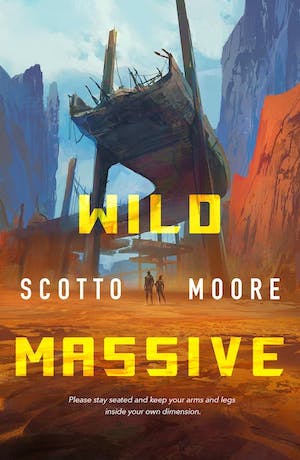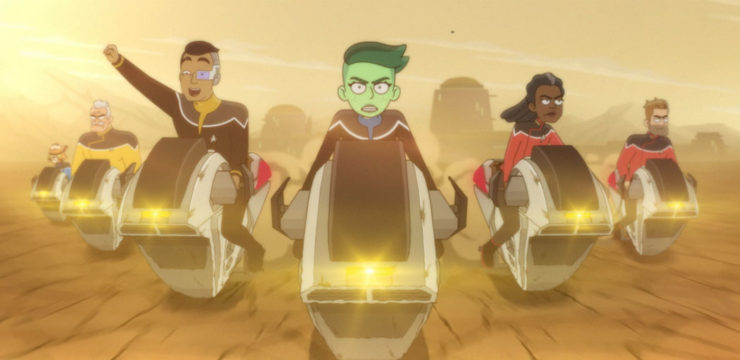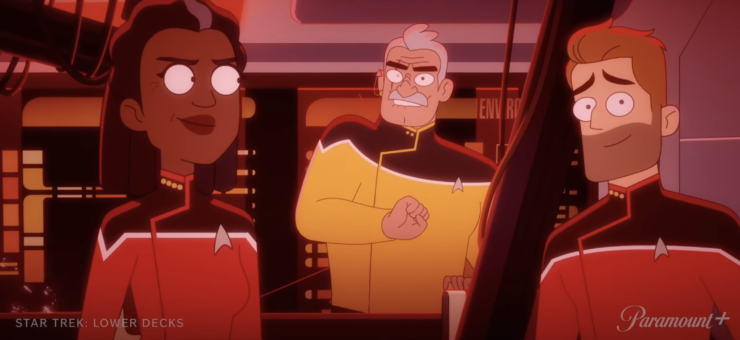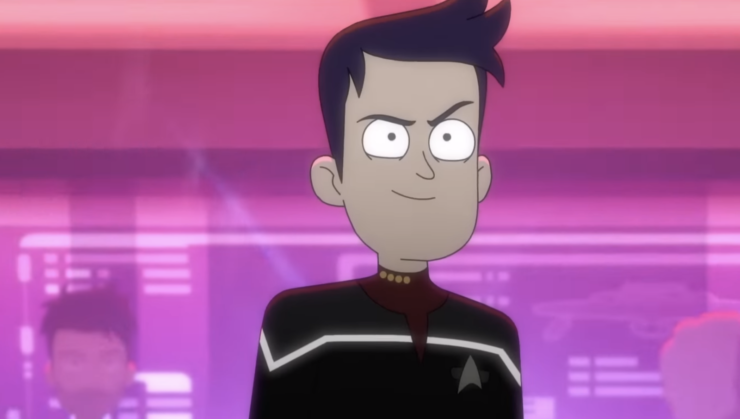For the second week in a row, we get a sequel to a first-season episode, and this time it’s significantly more meta. Back in “Crisis Point,” we had Mariner working through her psychological problems by rewriting Boimler’s re-creation of the crew as a Star Trek movie.
Two seasons later, we have the characters deliberately setting up another movie, this time with Boimler as Captain Bucephalus Dagger of the U.S.S. Wayfarer, a ship of the same class as the Titan. And this time, it’s Boimler who needs therapy…
SPOILER ALERT! ALL HANDS TO SPOILER STATIONS!
In this case, Boimler has received some really bad news: his transporter twin, William Boimler, currently serving under Captain Riker on Titan, has died in a freak accident. Boimler is bummed by this, and starts using the holodeck program to try to find the meaning of life.
Mariner winds up accompanying Boimler—initially because she thinks he’s gone nuts and she’s worried about him, and then later when she finds out about William’s death, she’s even more worried about him—leaving Tendi and Rutherford to play out the time-travel adventure.
Buy the Book


Wild Massive
It’s cute how this program—which started out life as Boimler re-creating the Cerritos senior staff on the holodeck to find out more about Captain Freeman so he could suck up to her—has modulated into a “starship team-up” storyline, with the Wayfarer and the Cerritos working together to have a wacky time-travel adventure.
Mariner, of course, spends most of the episode complaining about plot issues or clichés she sees. She also complains about Boimler just making a sequel to her movie, but Boimler points out that it was actually his program first…
The McGuffin for Crisis Point 2 is the chronogami, which holo-Freeman conveniently and clumsily explains is a portmanteau word for folding time (“chrono” for time with “origami,” the Japanese art of folding paper). The chronogami is on Cerritos, but it’s stolen by Romulan triplets. However, our heroes—after watching a computer presentation that looks like it was created in the 1980s (meant to be reminiscent of the Genesis Project video presentation from The Wrath of Khan)—are given a watch that has limited chronogamic functions (ahem), and they can use it to follow the triplets through time.
At this point, the party splits, as it were. Boimler-as-Dagger officially puts Tendi in charge of the mission, and she, Rutherford, and the holographic Cerritos senior staff chase the Romulan triplets, first to the Great Soolian Algae Crisis of 2341, then to Sydney in 1982 (where they’re mugged by mohawk’d punks carrying boom boxes, just like the guy on the bus in The Voyage Home—and also in Picard’s “Watcher”), then to the founding of the Federation in 2161.

My favorite part of this half of the plot is Rutherford, who is totally not taking it seriously—because it’s just a game. He’s eating food, singing the “Chu Chu” song from “Terminal Provocations” (“Such an earworm!”), stealing the mohawk’d punks’ clothes. Tendi gets fed up with him, yelling at him to stop fucking around, which confuses Rutherford. That’s when Tendi admits that she wants to really be a captain some day. Rutherford has to reassure her that she doesn’t need a holodeck movie to prove that she can be a good captain. However, good friend that he is, Rutherford then starts taking the whole simulation more seriously and follows Tendi’s orders. Her solution comes straight out of the end of season two of Picard, amusingly enough: they come back to the present and swap the chronogami that the Romulans steal from the Cerritos with the bomb that they were going to use to blow up the Federation’s founding.
Meanwhile, Mariner tries to help Boimler through his existential crisis, but he insists on following one of the random pseudo-religious figures on Tatasciore IX who claims to know the way to the meaning of life. They follow a map tattoo’d on his skin to Kitya, who will provide that meaning, eventually leading them to the third moon of Shatanari (a name with a can’t-be-a-coincidence similarity to the last name of a star of the original series). In the end, it’s just some giant rock creature that speaks in cheap aphorisms and we eventually find out that Kitya is actually Kitty Hawk, the Wright brothers’ groundbreaking airplane from 1903 (much like V’ger was actually Voyager 6 in The Motion Picture).
Boimler then collapses and hallucinates what appears to be a rerun of the Picard-and-Kirk-in-the-Nexus scenes from Generations, but instead of Kirk in a country home, it’s Sulu (having bought the place from Kirk, apparently). Captain Sulu gives Boimler some good advice about life, the universe, and everything, and then Boimler wakes up in sickbay to a lecture from T’Ana about hydrating while you’re playing on the holodeck.
And then in the end—after Mariner and Boimler both are grateful that Crisis Point 2 didn’t end with an out-of-nowhere cliffhanger—we get an out-of-nowhere cliffhanger. A Defiant-class ship decloaks, which turns out to belong to Section 31, who faked William Boimler’s death for reasons known only to them. We end on William’s diabolical laughter…
This is a delightful episode, mostly because they’re able to make snotty commentary about certain Trek storytelling clichés but lampshade them by having them be part of the holodeck movie rather than something happening in the show’s “real life.” Not that what happens in real life in the Trek universe is any less ridiculous, but the constructed nature of what they’re doing makes it easier to snark about it.
And throughout, we come back to one important theme, which I’m grateful for: that being in Starfleet means you do the right thing, even if it’s dangerous (and even if it’s not a real crisis). This is a nice thing to have reinforced after Peanut Hamper’s shitty behavior last week, even if the only stakes in this particular adventure are in service of a holodeck program that can be turned off at any time without consequence.
I’m less sanguine about yet another goddamn use of Section 31, which remains the single worst thing the otherwise-brilliant DS9 introduced to the Trek universe. 31’s tiresome presence has already warped and messed up Star Trek Into Darkness, Discovery, Enterprise, and lots of tie-in fiction, and it really needs to stop. I can only hope that LD will make them ridiculous or something…

Random thoughts
- One of the planets they go to in the movie is Tatasciore IX, named after Fred Tatasciore, the voice of Shaxs.
- More Trek movie references: When told there’ll be time travel, Mariner expresses concern that travelling back in time will result in a new timeline with younger actors in the next movie, a reference to the Bad Robot movies from 2009-2016. Tendi, Rutherford, and the holo-Cerritos crew chase the Romulan triplets through the desert, which is reminiscent of the dune buggy scene in Nemesis (though it’s also right out of any number of Star Wars productions as well, from Return of the Jedi to The Book of Boba Fett). And an alien named Knick Knack rescues Mariner and Boimler from their cell the exact same way Scotty rescued Kirk, Spock, and McCoy from the brig in The Final Frontier.
- The Section 31 agent who revives William Boimler—whose face is never seen—hands William a black combadge, just like the ones the 31 agents wore in Discovery season two. William expresses confusion over the use of special combadges for an agency that’s supposed to be secret, a confusion matched by everyone who watched Discovery season two, and one which your humble reviewer appreciated. I also appreciated that William let loose with an evil laugh when we see that he’s joining 31, because the organization is
- George Takei joins an exclusive club with his appearance as Sulu here, as someone who has appeared on at least three different Trek TV shows as the same character, after being a regular on the original series and also appearing in Voyager’s “Flashback.” The others include Michael Ansara as Kang (the original series’ “Day of the Dove,” DS9’s “Blood Oath,” Voyager’s “Flashback”), LeVar Burton as La Forge (TNG and Picard regular, Voyager’s “Timeless”), John deLancie as Q (TNG, Voyager, and Picard recurring, DS9’s “Q-Less”), Michael Dorn as Worf (TNG, DS9, and Picard regular), Jonathan Frakes as Riker (TNG and Picard regular, DS9’s “Defiant,” Voyager’s “Death Wish,” Enterprise’s “These are the Voyages…,” LD recurring), Gates McFadden as Crusher (TNG and Picard regular, Prodigy’s “Kobayashi”), Richard Poe as Evek (TNG and DS9 recurring, Voyager’s “Caretaker”), Armin Shimerman as Quark (DS9 regular, TNG’s “Firstborn,” Voyager’s “Caretaker,” LD’s “Hear All, Trust Nothing”), Marina Sirtis as Troi (TNG and Picard regular, Voyager recurring, Enterprise’s “These are the Voyages…,” LD’s “No Small Parts”), Brent Spiner as Data (TNG regular, Enterprise’s “These are the Voyages…,” Picard recurring), and Sir Patrick Stewart as Picard (TNG and Picard regular, DS9’s “Emissary”).
- Hearing Sulu lament the randomness of death just a short time after the death of Nichelle Nichols hits particularly hard, probably more so than the producers intended. The sadness in Takei’s voice when he talks about that is very real, though. And given how many of the original cast have passed on, it was already pretty poignant even before Nichols’ passing.
Keith R.A. DeCandido urges folks to support the Kickstarter for the eSpec Books Fantastic Novels, which includes three new works of fiction, one of which is Keith’s Phoenix Precinct, the sixth novel in his fantasy/police procedure series. The others are Aaron Rosenberg’s Yeti Left Home and Ef Deal’s Espirit de Corpse. There are plenty of cool rewards left! Click here to support it.










